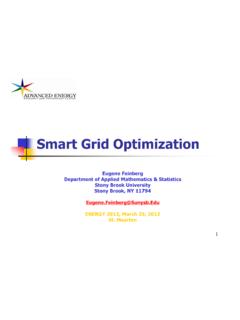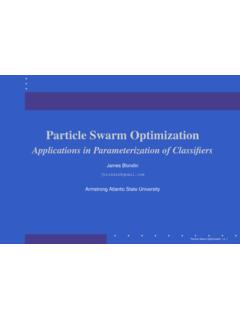Transcription of Parametric Study of a Genetic Algorithm using a Aircraft ...
1 Parametric Study of a Genetic Algorithm using a Aircraft design optimization problem Andre C. Marta Dept. of Aeronautics and Astronautics Stanford University Stanford, California 94305. ABSTRACT. This work shows how a preliminary Aircraft design can be achieved by means of Genetic algorithms (GA). The Aircraft major parameters are mapped into a chromosome like string. These include the wing, tail and fuselage geometry, thrust requirements and operating parameters. GA operators are performed on a population of such strings and natural selection is expected to occur. The design performance is obtained by using the Aircraft range as the fitness function.
2 Different GA parameters and selection methods fitness and ranking are tested and their impact on the Algorithm efficiency is analyzed. The constraints implementation is also studied. 1. Introduction At first glance, the definition of the best Aircraft design is very simple: the fastest, most efficient, quietest, most inexpensive airplane with the shortest field length. Unfortunately, such an airplane cannot exist. One can only make one thing best at a time, as illustrated in figure 1. The most inexpensive airplane would surely not be the fastest, as well as the most efficient would not be the most comfortable.
3 In other words, the overall airplane is always a compromise in some sense. Various quantities are included in a function termed the figure of merit or objective, such as weight, flight controls, structures, manufacturing, aerodynamics, noise and propulsion characteristics, whose relative weights depends on the intended application for the Aircraft . Figure 1 Make one thing best at a time Once the definition of best has been decided, one must find a way of relating the design variables to the goal. This process is show schematically in figure 2. Objective design Model and Variables Constraints Figure 2 Modeling In Aircraft design , this process can be extremely complex.
4 The number of parameters needed to completely specify an airplane is astronomical, so a combination of approximation, experience and statistical information on similar Aircraft has to be used to reduce the number of design variables. There are several methods by which one chooses the design variables leading to the best design . Two approaches to optimization are commonly used: 1) Analytical: this approach is very useful for fundamental studies but requires great simplification (often oversimplification); 2) Numerical: in most Aircraft design problems, the analysis involves iterations, table look-ups or complex computations.
5 In these cases, direct search methods are employed, namely grid searching, random searches, nonlinear simplex and gradient methods. In Aircraft design , problems are often constraint-bounded, that is, the constraints dictate the values of the design variables. When many constraints are active at the optimum, the value of the gradient (for continuously differentiable objective functions) is not zero. For these problems, the methods have to be modified. One approach to constrained optimization is simply to add a penalty to the objective function when the constraints are violated.
6 2. Background In the Aircraft design field, many optimization works have been done, ranging from simple Parametric studies to highly detailed configurations, involving thousands of design variables. Today, the Aircraft design community no longer seeks the best aerodynamic or the best structural solutions, but rather the optimal overall solution, in what is called multidisciplinary optimization (MDO). Typically, such works make use of gradient methods to find the optimal solution, requiring massive computations to determine the numerical derivatives, as seen in Alonso, Martins and Reuther (2003).
7 When the objective function is not continuous, the gradient based methods cannot be immediately applied. In such cases, the use of other search algorithms might be considered. Within this context, Genetic algorithms (GA) are becoming more and more popular in many science fields when all other conventional algorithms seem to fail. However, in the Aircraft design field, GAs are yet far from being widely used despite their robustness and proven efficiency. 3. Statement of the problem In order to show how an Aircraft design problem can be solved by means of GA, a preliminary design problem was implemented, using a restricted number of design variables and the Breguet equation as the objective function.
8 This equation expresses the Aircraft range R, that is, maximum distance flown, given the propulsive, aerodynamic and structural characteristics of the Aircraft . V L Wi . R= ln (eq. 1). SFC D W f . In equation 1, V is the cruise velocity, SFC is the specific fuel consumption at cruise speed and altitude, L is the airplane lift, D is the airplane drag, Wi is the initial airplane weight and Wf is the final airplane weight. Further details can be seen in Shevell (1983). The right-hand side terms in equation 1 can be estimated by combining several estimates described in Kroo (2003), using the following design variables: fuselage diameter, fuselage length, cruise altitude, take-off weight, wing span, wing chord, horizontal tail span, vertical tail span, angle of attack, location of wing and location of the tail.
9 As stated in section 1, each airplane is designed to meet different constraints, which are imposed by the specified requirements. In this paper, the constraints selected refer to a medium size airplane, typically a regional jet, flying at subsonic speed. There were seven constraints, in addition to the allowable range for each of the eleven design variables, whose values are given in table 1. Table 1 Range of design variables and other constraints design variable Admissible values Others constraints Admissible values Fuselage diameter 60 < d < 200 in Number of seats 60 < seats < 80.
10 Fuselage length 70 < l < 150 ft Mach number M < Cruise altitude 10,000 < h < 50,000 ft Tail after wing xwoverl < xtoverl Take-off weight 60,000 < tow < 100,000 lbs Horizontal tail volume < Vh < Wing span 50 < b < 150 ft Vertical tail volume < Vv < Wing chord 5 < c < 20 ft Moment coefficient about < cm_cg < Horizontal tail span 20 < bh < 70 ft Zero fuel weight zfw < tow Vertical tail span 5 < bv < 20 feet Angle of attack 1 < alpha < 16 deg Location of wing < xwoverl < Location of tail < xtoverl < The chosen design variables together with ten additional constants (fuselage nose and tail fineness, seat pitch, Osvald efficiency factor, wing sweep angle, airfoil thickness-to-chord ratio, horizontal and vertical tail aspect ratio.)






